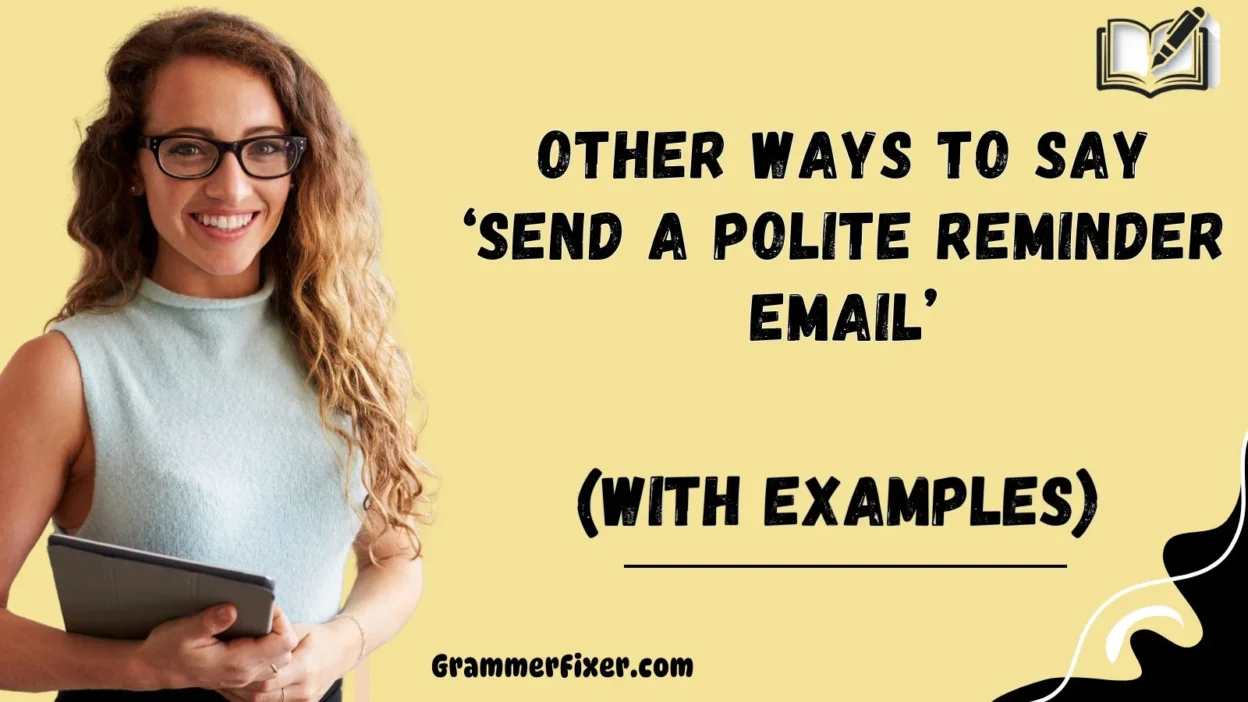In professional communication, finding the right words to express care and courtesy can make a world of difference. Whether you’re reminding a client about an invoice, following up on a proposal, or gently checking on a colleague’s progress, the tone of your reminder email defines how your message is received. Using thoughtful, warm phrasing can help you sound polite, professional, and considerate—without coming across as pushy or impatient.
Below are 30 meaningful alternatives to help you send a polite reminder email that reflects both empathy and professionalism.
What Does “Send a Polite Reminder Email” Mean?
A polite reminder email is a message written to gently prompt someone to take action, respond, or remember a task—without sounding demanding or rude. It’s a communication tool often used in workplaces to follow up on pending matters while maintaining respect and positive relationships.
When to Use “Send a Polite Reminder Email”?
You can use a polite reminder email when:
- A response or action is overdue.
- You’re confirming a previously discussed deadline.
- You’re waiting for payment, approval, or confirmation.
- You want to follow up on an unacknowledged message or request.
The key is timing and tone—waiting an appropriate amount of time and crafting your message with understanding and professionalism.
Is It Professional or Polite to Say “Send a Polite Reminder Email”?
Yes, absolutely. Sending a polite reminder email is both professional and courteous—as long as your wording is considerate. It helps maintain communication flow, shows responsibility, and signals your respect for others’ time and commitments.
Pros or Cons of Using “Send a Polite Reminder Email”
Pros:
- Keeps communication organized and proactive
- Reinforces accountability without confrontation
- Builds a professional image
Cons:
- Can sound repetitive if phrased bluntly
- Risk of appearing impatient if timing isn’t right
That’s why exploring alternative phrases helps you maintain warmth and professionalism.
1. Follow Up Kindly
Meaning: A gentle phrase that emphasizes warmth and courtesy in checking in.
Detailed Explanation: This phrasing works perfectly when you want to remind someone softly, showing you value their time.
Example: “Just following up kindly on my previous message regarding the meeting schedule.”
Best Use: Client or coworker follow-ups after 3–5 days.
Worst Use: When discussing urgent deadlines that require immediate attention.
Tone: Warm, professional, and empathetic.
2. Gentle Reminder
Meaning: A classic and subtle phrase that conveys care and patience.
Detailed Explanation: “Gentle” softens the word “reminder,” helping you sound approachable rather than demanding.
Example: “This is just a gentle reminder about tomorrow’s deadline.”
Best Use: Ideal for recurring tasks, invoices, or friendly nudges.
Worst Use: In legal or time-sensitive matters that require strong follow-up.
Tone: Calm, neutral, and polite.
3. Just Checking In
Meaning: A friendly, conversational way to follow up.
Detailed Explanation: Helps maintain natural dialogue without applying pressure.
Example: “Just checking in to see if you had a chance to review my proposal.”
Best Use: Works well in informal or team-based communication.
Worst Use: When writing to a senior executive or unfamiliar client.
Tone: Friendly, approachable, and kind.
4. Touching Base
Meaning: A business-friendly phrase implying connection and continuity.
Detailed Explanation: Suggests collaboration and teamwork rather than insistence.
Example: “I wanted to touch base regarding the status of the report.”
Best Use: Team updates, project coordination, and follow-ups with peers.
Worst Use: Formal or first-time correspondence with external partners.
Tone: Professional, casual, and collaborative.
5. Circling Back
Meaning: Signals a respectful follow-up, often used in corporate environments.
Detailed Explanation: Implies that the topic was previously discussed, maintaining continuity.
Example: “Just circling back to see if you’ve had a chance to look over my proposal.”
Best Use: When referring to a past discussion or shared context.
Worst Use: When addressing someone unfamiliar with the initial conversation.
Tone: Polished, courteous, and engaging.
6. Wanted to Follow Up
Meaning: A simple, neutral way to reopen a conversation.
Detailed Explanation: Keeps the message professional without unnecessary pressure.
Example: “I wanted to follow up on my previous email about the new marketing proposal.”
Best Use: Professional emails to clients or superiors.
Worst Use: Informal chats or when a direct reminder is needed.
Tone: Respectful, professional, and balanced.
7. Checking Back
Meaning: Expresses curiosity and responsibility in ensuring progress.
Detailed Explanation: Reflects your attentiveness while still maintaining politeness.
Example: “Checking back to see if there are any updates on the shipment schedule.”
Best Use: Project updates or task progress tracking.
Worst Use: When used too soon after the first message—it can sound impatient.
Tone: Courteous, thoughtful, and attentive.
8. Wanted to See If You Had a Chance
Meaning: Invites a response gently while acknowledging the recipient’s busy schedule.
Detailed Explanation: Shows empathy and respect for others’ time.
Example: “I just wanted to see if you had a chance to review my previous message.”
Best Use: Ideal for clients or busy professionals.
Worst Use: When multiple reminders have already been sent.
Tone: Soft, professional, and understanding.
9. Following Up as Promised
Meaning: Indicates you’re honoring your previous commitment to reconnect.
Detailed Explanation: Adds professionalism by showing reliability and consistency.
Example: “Following up as promised regarding the project update.”
Best Use: After previously scheduling a follow-up.
Worst Use: When the recipient didn’t agree to a specific follow-up timeline.
Tone: Responsible, professional, and confident.
10. Kindly Reminder
Meaning: Similar to “gentle reminder,” but adds a hint of formal courtesy.
Detailed Explanation: The adverb “kindly” emphasizes politeness and consideration.
Example: “This is a kindly reminder that the payment is due on Friday.”
Best Use: For polite, professional payment or deadline reminders.
Worst Use: Informal internal communication—it can sound overly formal.
Tone: Respectful, formal, and refined.
11. Following Up Gently
Meaning: A softer way to express persistence with empathy.
Detailed Explanation: This phrase reassures the recipient that your follow-up is friendly and non-pressuring.
Example: “I’m following up gently to see if you’ve had time to look over the contract.”
Best Use: For sensitive or delayed responses where tact is needed.
Worst Use: When the situation calls for a firm reminder or urgent response.
Tone: Polite, tender, and understanding.
12. Quick Reminder
Meaning: A short and practical nudge meant to refresh someone’s memory.
Detailed Explanation: Works well when time is limited and you’ve already built rapport.
Example: “Just a quick reminder that our meeting is tomorrow at 2 PM.”
Best Use: Routine scheduling, informal team updates.
Worst Use: When the matter is serious or overdue—it may sound too casual.
Tone: Friendly, brisk, and conversational.
13. Kindly Checking In
Meaning: Combines formality (“kindly”) with a caring tone (“checking in”).
Detailed Explanation: It expresses courtesy and genuine interest.
Example: “Kindly checking in to see if you received my last email.”
Best Use: Formal business follow-ups or client-facing situations.
Worst Use: Internal, casual team messages—it might seem stiff.
Tone: Polished, courteous, and diplomatic.
14. Thought I’d Follow Up
Meaning: Makes your reminder sound thoughtful and spontaneous.
Detailed Explanation: Adds a touch of personality, reducing any pressure.
Example: “I thought I’d follow up to make sure you saw my previous note.”
Best Use: Friendly reminders with colleagues or long-term clients.
Worst Use: When communicating with new clients or executives.
Tone: Relaxed, natural, and approachable.
15. Friendly Reminder
Meaning: A lighthearted and approachable phrase often used in office culture.
Detailed Explanation: “Friendly” signals your intent to help, not push.
Example: “Just a friendly reminder that your feedback is due by Friday.”
Best Use: Internal team messages or recurring tasks.
Worst Use: Legal or financial reminders where tone must remain formal.
Tone: Casual, cheerful, and kind.
16. Circling Around
Meaning: A variant of “circling back,” signaling another check-in without sounding repetitive.
Detailed Explanation: Suggests continuity while keeping things informal.
Example: “Just circling around to confirm if you’ve had a chance to review my proposal.”
Best Use: Informal workplace updates or mid-project follow-ups.
Worst Use: Highly formal or external business communications.
Tone: Relaxed, open, and cooperative.
17. Following Up to Ensure You Saw This
Meaning: Emphasizes care that your message reached them.
Detailed Explanation: Balances assertiveness with empathy by framing your follow-up as concern.
Example: “Following up to ensure you saw my earlier message about next week’s meeting.”
Best Use: When emails might have been missed or filtered.
Worst Use: If you’ve already received confirmation—it may seem inattentive.
Tone: Responsible, caring, and attentive.
18. Checking If This Slipped Through
Meaning: Suggests understanding that oversights happen.
Detailed Explanation: Politely reminds the recipient without blame.
Example: “Just checking if this slipped through your inbox—it happens!”
Best Use: For peers or friendly clients with whom you have an established rapport.
Worst Use: For senior management—it can sound too casual.
Tone: Empathetic, light, and informal.
19. Wanted to Bring This Back to Your Attention
Meaning: A formal phrase that implies a gentle nudge.
Detailed Explanation: It acknowledges that people get busy while subtly renewing focus.
Example: “I wanted to bring this back to your attention before our next meeting.”
Best Use: Long-term projects, client check-ins, or pending deliverables.
Worst Use: Quick or informal reminders—it sounds too formal.
Tone: Respectful, composed, and professional.
20. Revisiting Our Previous Conversation
Meaning: Adds context and professionalism by referencing prior communication.
Detailed Explanation: A polished way to remind someone without sounding repetitive.
Example: “Revisiting our previous conversation about the budget proposal.”
Best Use: Formal client interactions or follow-ups after several weeks.
Worst Use: Short-term reminders within the same week.
Tone: Thoughtful, professional, and polished.
21. Wanted to Touch Base Again
Meaning: Reflects both continuity and professional courtesy.
Detailed Explanation: Suggests collaboration while maintaining a friendly tone.
Example: “I wanted to touch base again regarding your feedback on the new plan.”
Best Use: Ongoing partnerships or multi-stage projects.
Worst Use: When the other person hasn’t responded to multiple prior messages.
Tone: Cooperative, upbeat, and respectful.
22. Sending a Quick Nudge
Meaning: A light and friendly way to say “reminder.”
Detailed Explanation: The word “nudge” adds informality and charm without offense.
Example: “Sending a quick nudge about your approval on the document.”
Best Use: Internal teams, friendly clients, or creative industries.
Worst Use: Legal or financial matters—it can sound too playful.
Tone: Easygoing, warm, and casual.
23. Following Up for Visibility
Meaning: A strategic and neutral phrasing often used in corporate communication.
Detailed Explanation: It highlights transparency and process instead of pressure.
Example: “Following up for visibility on the project timeline.”
Best Use: Project management, reporting, or cross-team coordination.
Worst Use: When emailing individuals with no shared responsibility.
Tone: Strategic, neutral, and polite.
24. Checking the Status
Meaning: A straightforward way to request updates.
Detailed Explanation: Ideal when the conversation involves measurable progress.
Example: “Checking the status of the pending invoice submission.”
Best Use: Internal operations or workflow tracking.
Worst Use: When used without context—it may sound abrupt.
Tone: Direct, efficient, and professional.
25. Reaching Out Regarding
Meaning: Opens the email with clear intent and formality.
Detailed Explanation: A strong, neutral introduction that feels respectful.
Example: “Reaching out regarding the proposal I sent last week.”
Best Use: Formal emails or first-time reminders.
Worst Use: Repetitive follow-ups—it can sound robotic.
Tone: Polite, structured, and formal.
26. Wanted to Confirm If You Received My Last Email
Meaning: A polite, practical check to ensure communication continuity.
Detailed Explanation: Implies consideration for potential email errors or delays.
Example: “I wanted to confirm if you received my last email about the updated schedule.”
Best Use: Technical, administrative, or first follow-ups.
Worst Use: When used repeatedly—it can sound impatient.
Tone: Courteous, neutral, and clear.
27. Hoping for an Update
Meaning: A gentle way to express anticipation without pressure.
Detailed Explanation: Uses emotional intelligence to soften your request.
Example: “Hoping for an update on the project timeline when convenient.”
Best Use: Client relations or when delays are understandable.
Worst Use: When urgency is critical or a deadline is missed.
Tone: Patient, calm, and empathetic.
28. Following Up Respectfully
Meaning: Communicates persistence and politeness together.
Detailed Explanation: Ideal for senior or executive-level correspondence.
Example: “Following up respectfully regarding the pending approval.”
Best Use: Leadership communication or external partnerships.
Worst Use: Informal or casual workplace chats.
Tone: Elegant, sincere, and professional.
29. Wanted to Bring This to Your Notice
Meaning: A formal and authoritative expression often used in administrative or official settings.
Detailed Explanation: Useful when you need acknowledgment of something overlooked.
Example: “I wanted to bring this to your notice before finalizing the report.”
Best Use: Business, compliance, or process reminders.
Worst Use: Casual or friendly emails—it can sound stiff.
Tone: Formal, precise, and authoritative.
30. Kindly Let Me Know
Meaning: A closing reminder that encourages a reply courteously.
Detailed Explanation: Encourages engagement and response while remaining polite.
Example: “Kindly let me know if you’ve had time to review the contract.”
Best Use: When expecting a response or decision.
Worst Use: As an opener—it’s best suited for closing statements.
Tone: Gentle, polite, and professional.
Conclusion
Finding the right phrasing to send a polite reminder email can completely change the tone of your message. These 30 carefully crafted alternatives let you express follow-ups with empathy, tact, and professionalism—ensuring that you stay considerate while achieving your communication goals.
Remember, it’s not just about reminding—it’s about respecting time, maintaining relationships, and expressing care through your words.



